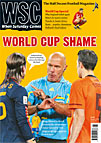 South America’s beaten semi-finalists were neither of the teams you might have expected. Sam Kelly reports
South America’s beaten semi-finalists were neither of the teams you might have expected. Sam Kelly reports
At around 10.30pm on Monday July 12, the Uruguayan World Cup squad touched down at Carrasco International Airport just outside Montevideo to a country which, when it bade them farewell, could scarcely have imagined the circumstances in which they’d return. World Cup semi-finalists? Uruguay? It’s not meant to happen in the 21st century, surely?
As if simply getting to “a party we weren’t invited to” in the words of manager Óscar Washington Tabárez before the semi-final against Holland wasn’t enough, a Uruguayan was named by FIFA as the best player of the tournament. The same man, Diego Forlán, was joint top scorer. Diego Lugano, Edinson Cavani and – much as some around the world might hate to admit it – Luis Suárez all contributed hugely as well. They might not have won the trophy, but for a change it’s not a cliche to suggest that the players have won a place in the hearts of their countrymen. I was in Montevideo for the semi-final and a small group of fans were still celebrating the team’s achievement in reaching the match at half-past midnight – over seven hours after the game finished and Uruguay had been knocked out of the Cup. Several of the fans I spoke to were close to tears they were so proud of their team. One or two couldn’t even understand why an Englishman – someone from a “big footballing nation” as one put it – had any interest in Uruguay. Never mind that they’ve won twice as many World Cups as England; Uruguayans knew full well they were never expected to be candidates at this one.
Success will certainly lead to transfers for some of the squad – at the time of writing, Barcelona are reported to be interested in Suárez, AC Milan want Martín Cáceres and Egidio Arévalo Ríos has already left Peñarol for Cagliari. That transfer at least will have an effect of sorts:Peñarol owe their squad three months’ wages, and will be able to pay off the debt with their share of the fee. “Share of the fee” is the operative phrase with the current state of South American football finance. Peñarol will only receive one-third of the transfer money, the other $2 million (£1.3m) to be split between financiers and Ríos’s agents. Likewise, Martín Silva, the World Cup backup goalkeeper, could move from Defensor Sporting to the Argentine league, but his club won’t expect to benefit too much from that.
Beyond the financial concerns of their employers, though, the players were given a heroes’ return to Montevideo, where they were named Illustrious Citizens of Montevideo, the capital’s highest honour. Hundreds of thousands of Uruguayans cheered the team along the city’s waterfront and it took the bus over four hours to reach the Palacio Legislativo, Uruguay’s parliament. Captain Lugano expressed surprise at the size of the welcome: “Back in South Africa we were told people were happy but we could never imagine this. It exceeds what we deserve. We have just done what football players do in this country, give their lives for their squad.” There aren’t many better cities to be in, if one likes one’s football history, than Montevideo – the air almost seems to smell of glories long passed. Plaques near the dockside commemorate the return home of the gold medal-winning football teams from the 1924 and 1928 Olympic Games, while reminders of the 1930 and 1950 World Cup wins are everywhere. This might only have been a semi-final appearance, but some form of memorial is bound to be created for it as well.
On the morning of the Dutch game, La República ran with a delightfully self-effacing sub-heading. “If the Oranje don’t win today,” it read, “Uruguay could become, for the first time ever, the World Cup runners-up.” The emphasis on the need for the opposition to mess up, and the recognition that even if the final was reached they’d still be massive outsiders, were modest enough on their own. Casting the two previous titles to one side for a moment, though, was a real recognition that the competition has changed enormously in the 60 years since they surprised Brazil in the Maracanã.
Although no Uruguayans expect a return to the glory days of the early 20th century, they will at least be able to watch a national side playing with more confidence in the not too distant future. It’s been a long, long time since they were the last South American side standing at a World Cup. Brazil and Argentina aren’t the only bigger nations whose efforts were put to shame by Uruguay’s achievement in South Africa, but they could have the most to fear from a newly confident Uruguay. In 2011, the Copa América takes place in Argentina – perhaps a team outside the continent’s big two might have the confidence to gatecrash another party.
From WSC 282 August 2010